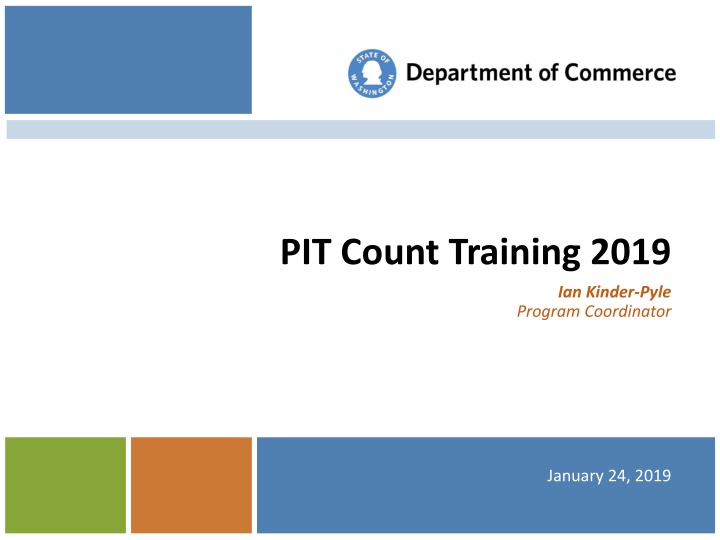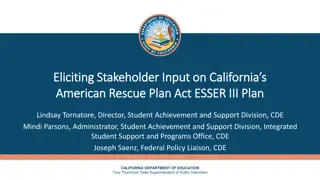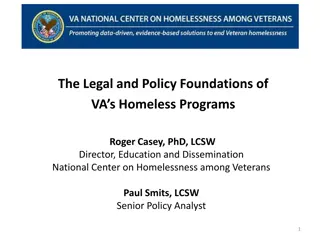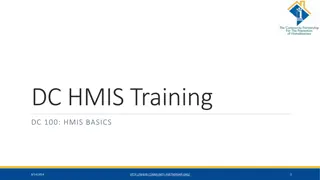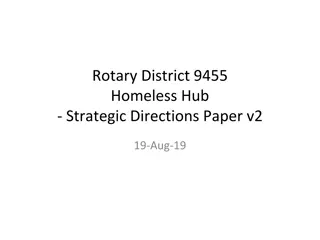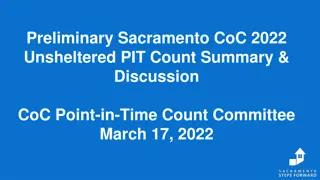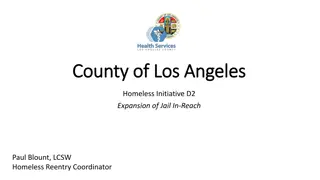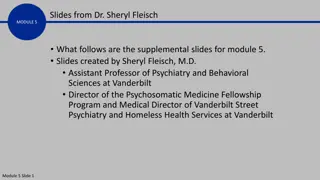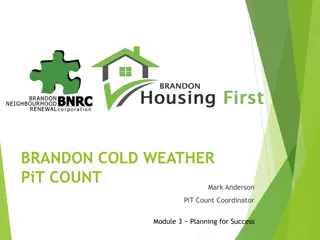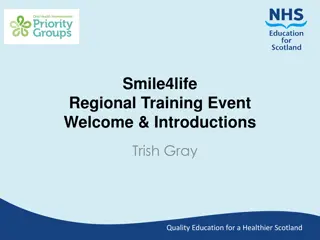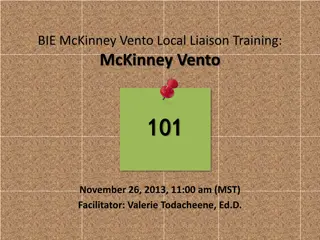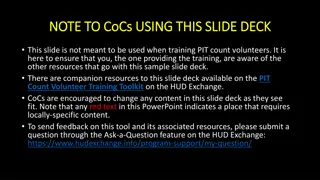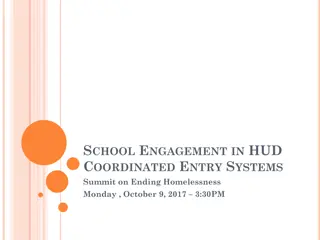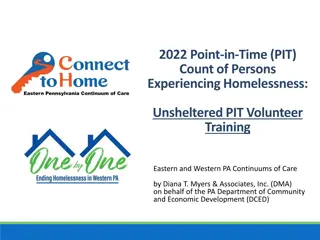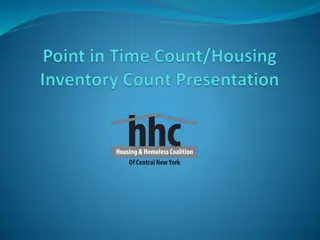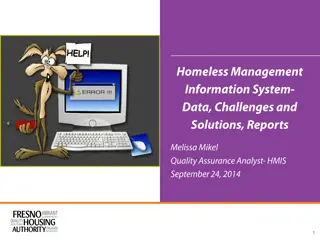PIT Count Training for Homeless Population
This content provides insights into the PIT Count Training 2019 aimed at understanding and addressing homelessness. It covers topics such as unsheltered and sheltered counts, individuals included and excluded in the PIT count, and strategies to address subpopulations. Additionally, it clarifies what qualifies as unsheltered, including specifics on RVs, and outlines criteria for individuals living in supervised shelters. The content sheds light on crucial aspects to consider while conducting homeless counts to ensure accuracy and inclusivity.
Download Presentation

Please find below an Image/Link to download the presentation.
The content on the website is provided AS IS for your information and personal use only. It may not be sold, licensed, or shared on other websites without obtaining consent from the author.If you encounter any issues during the download, it is possible that the publisher has removed the file from their server.
You are allowed to download the files provided on this website for personal or commercial use, subject to the condition that they are used lawfully. All files are the property of their respective owners.
The content on the website is provided AS IS for your information and personal use only. It may not be sold, licensed, or shared on other websites without obtaining consent from the author.
E N D
Presentation Transcript
PIT Count Training 2019 Ian Kinder-Pyle Program Coordinator January 24, 2019
Agenda PIT Count Overview Strategies Subpopulations Questions
Unsheltered Count Individuals and households with a primary nighttime residence that is a public or private place not designed for or ordinarily used as a regular sleeping accommodation for human beings, including a car, park, abandoned building, bus or train station, airport, or camping ground. *Vehicles/Boats lacking basic amenities Heating Drinking water Electricity
Unsheltered Count RVs (and boats designed to live in) don t count as unsheltered. However, if the surveyor comes across (or knows about) RVs outside of RV parks that are in such a broken-down or inoperative state that they are no longer fit for human habitation (no longer has the features that distinguish it from a regular vehicle like the ability to cook or bathe) then they do count as unsheltered. Most RVs would not fall in this category only those that are no better than automobiles or tents with people living there because they have no adequate sheltered options. Mobile homes would not fall into this category and are considered housed.
Sheltered Count Individuals and households living in a supervised publicly or privately operated shelter designated to provide temporary living arrangement (including congregate shelters, transitional housing, and hotels and motels paid for by charitable organizations or by federal, state, or local government programs for low-income individuals).
People Who Must NOT Be Included in the PIT A. Persons residing in PSH programs, including persons housed using HUD Veterans Affairs Supportive Housing (VASH) vouchers. B. Persons residing in RRHD projects, funded in the FY2008 CoC Competition. C. Persons residing in OPH housing, including persons in a GPD Transition in Place (TIP) project on the night of the count. D. Persons counted in any location not listed on the HIC (e.g., staying in projects with beds/units not dedicated for persons who are homeless). E. Persons temporarily staying with family or friends (i.e., doubled-up or couch surfing ). F. Persons residing in housing they rent or own (i.e., permanent housing), including persons residing in rental housing with assistance from a RRH project on the night of the count. G. Persons residing in institutions (e.g., jails, juvenile correction facilities, foster care, hospital beds, detox centers).
Sheltered Count EMERGENCY SHELTER any facility, the primary purpose of which is to provide temporary or transitional shelter for the homeless in general or for specific populations of the homeless. TRANSITIONAL HOUSING: A project that has as its purpose facilitating the movement of homeless individuals and families to permanent housing within a reasonable amount of time (usually 24 months). Transitional housing includes housing primarily designed to serve deinstitutionalized homeless individuals and other homeless individuals with mental or physical disabilities and homeless families with children.
PIT Changes Consistent with the updated 2017 HMIS Data Dictionary, HUD changed the Don t identify as male, female, or transgender gender response option to Gender Non-Conforming (i.e. not exclusively male or female).
PIT Changes HUD is clarifying that when reporting on any chronically homeless households whether or not there are children if one member of the household qualifies as chronically homeless, then all persons in the household should be counted as chronically homeless.
Strategies Places to count unsheltered persons Agencies to Partner with Faith Based Organization/non HMIS users PATH Outreach Workers School Districts http://www.k12.wa.us/HomelessEd/ContactList.aspx Law Enforcement Hosting Project Connect Events
Volunteers & Canvassing Recruiting Volunteers Hiring Formerly homeless persons Collecting Information Before the Count https://www.hudexchange.info/faqs/3124/can-i-use- a-phone-or-web-based-survey/ Incentives for clients Collecting Contact Info for clients Rules about Personally Identifying Information/Consent
Data De-duplication Using coordinated entry Gender, Race, Ethnicity Upcoming Webinar Trainings How Local Communities Use their Data
Race & Ethnicity What is the difference between race and ethnicity? Wouldn t Hispanic or Latino be someone s race? Do you know if your ancestors were originally from a country like Spain, somewhere in Africa, or are you part of an indigenous group? https://www.hudexchange.info/reso urces/documents/hmis-data- standards-faqs-3-4-3-5-3-6.pdf
Youth Count HUD and its federal partners established 2017 as the baseline year for measuring progress in ending youth homelessness in the context of the PIT count. https://www.hudexchange.info/news/improving-our- understanding-of-youth-experiencing-homelessness/ https://www.hudexchange.info/resources/documents/Promisin g-Practices-for-Counting-Youth-Experiencing-Homelessness-in- the-PIT-Counts.pdf https://www.hudexchange.info/homelessness- assistance/resources-for-homeless-youth/youth-count/ http://voicesofyouthcount.org/wp- content/uploads/2016/10/Voices-of-Youth-Count-Toolkit- FINAL.pdf
Chronic Homelessness Definition A. Is homeless and lives in a place not meant for human habitation, a safe haven, or in an emergency shelter; and B. Has been homeless and living or residing in a place not meant for human habitation, a safe haven, or in an emergency shelter continuously for at least 1 year or on at least four separate occasions in the last 3 years where the combined length of time homeless in those occasions is at least 12 months; and C. Has a disability. For households of more than one person, when one household member qualifies as chronically homeless, all members of that household should be counted as chronically homeless.
Presented by: Ian Kinder-Pyle Program Coordinator (360) 725-2976 ian.kinder-pyle@commerce.wa.gov www.commerce.wa.gov
